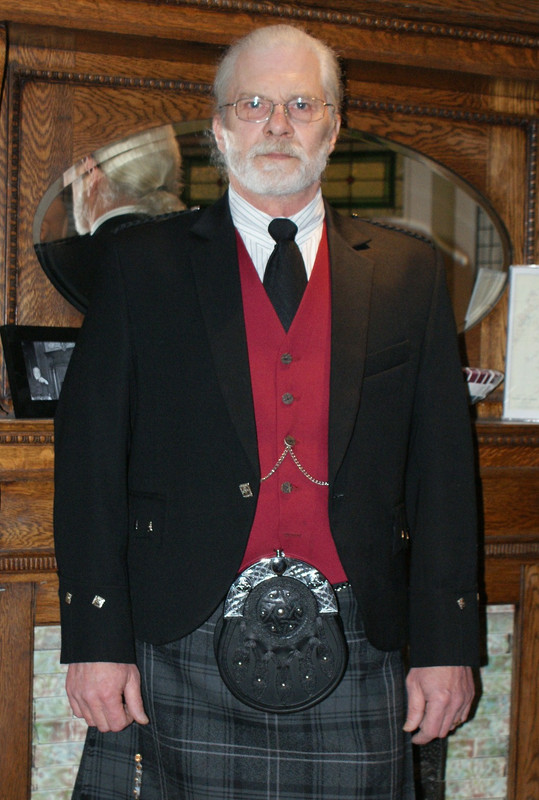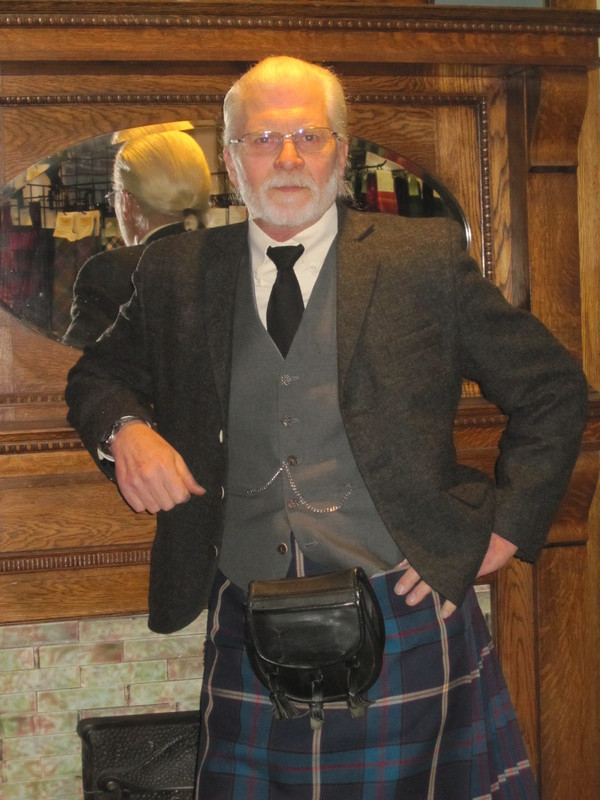|
-
26th December 19, 08:15 PM
#1
Odd waistcoat with black barathea Argyll?
Is there any convention for/against wearing an odd waistcoat with a black barathea Argyll jacket?
My wife gave me two waistcoats for Christmas. One is distinctly tweed. The other, however, is a solid, dark burgundy, wool waistcoat with (round) silver buttons. I was wondering whether there is any convention for/against wearing it with my black barathea Argyll jacket for a nighttime function? Like the semi-formal New Year's Eve party several days from now.
-
-
26th December 19, 10:19 PM
#2
You tell me how you think it looks.

Although I own waistcoats made from the same fabric as the jacket I will, more often than not, wear a waistcoat of a contrasting fabric.

Last edited by Steve Ashton; 26th December 19 at 10:26 PM.
-
The Following 6 Users say 'Aye' to Steve Ashton For This Useful Post:
-
27th December 19, 04:16 AM
#3
20972F86-2B0D-458D-8B9B-A91436172D52.jpeg
HoL just shared this 1899 painting of the MacKinnon children on their FB page. Rather like the way the yellow waistcoats would really compliment a tartan with a yellow line in it.
-
The Following User Says 'Aye' to Luke MacGillie For This Useful Post:
-
27th December 19, 05:46 AM
#4
I agree with Steve and Luke that contrasting waistcoats are both traditional and stylish. Try it on and take a look in the mirror to see how it works on you. And please share a picture with us.
Andrew
-
-
27th December 19, 10:10 AM
#5
A jacket in black Barathea will have the appearance of an Evening Dress jacket. In Evening Dress it has long been common to wear non-matching waistcoats, particularly tartan, red, and buff.
A tweed waistcoat would look out of place due to the mixing of Day Dress and Evening Dress.
For example, here from 1909 is a black Argyll jacket worn with a white waistcoat

And here in the 1930s is a Prince Charlie coatee worn with tartan waistcoat. The same outfit might well have been worn with a black Prince Charlie.

As far back as the mid-19th century is was common to wear red, buff, and tartan waistcoats with black, dark blue, or brown jackets.
For example in The Highlanders Of Scotland (1860s) 42 kilted men have visible waistcoats, and they break down as follows:
Tartan: 14
Matching the jacket colour: 13
Red: 10
Buff or white: 3
Brown: 1
Charcoal: 1
So in Victorian times a waistcoat matching the jacket was in the minority.
From HOS, tartan and red waistcoats

Brown (dull burgundy?) waistcoat

In Edwardian times: a buff waistcoat with tweed jacket

Modern times: The Duke of Rothesay wearing tartan waistcoat

Last edited by OC Richard; 27th December 19 at 10:26 AM.
Proud Mountaineer from the Highlands of West Virginia; son of the Revolution and Civil War; first Europeans on the Guyandotte
-
The Following 3 Users say 'Aye' to OC Richard For This Useful Post:
-
27th December 19, 11:45 AM
#6
Thanks Steve, Luke and Richard. That was exactly what I was wanting to know.
 Originally Posted by Steve Ashton

You tell me how you think it looks.
I knew I liked the look. I had even seen that top photo before. Due to my faulty memory, however, I had misremembered your jacket as charcoal tweed, rather than black barathea.
-
-
27th December 19, 03:54 PM
#7
The top jacket in my photo is a standard Black Barathea Argyle style with square buttons.
Note please that the buttons on the red vest are round horn.
The second photo is of a Tweed Kilt Kut suit coat. This jacket is a three button front, de-militarized version, much more like a regular suit coat.
The charcoal gray jacket and dove gray vest have the same buttons.
In the period up to WWI a man may own only one suit coat. But he may have many vests and would change up his outfit by wearing a different vest.
In general, Tweed was considered a less formal type of attire suitable for outdoors or the country. More formal occasions would usually mean a solid color with darker being more formal that lighter.
So, if I am attending an outdoor event or one of the jacket and tie level of formality you will usually see me in the Charcoal Tweed KKSC. Usually with contrasting vest.
For a slightly more formal setting, say a funeral or business attire where the men wear 3 piece suits, I may wear a matching vest.
After 6 pm or for a tad more formal event with a Scottish theme I may wear an Argyle. I would not usually wear an Argyle style jacket outside of a Scottish themed event, but if I did, I would view a contrasting vest less formal than a matching vest.
The idea is to match what you wear with the level of formality of the event you are attending. I have seen Prince Charlie jackets worn at Highland Games and it just looks odd. But an Argyle style jacket with matching matching vest at a Burn's dinner is quite common.
About 99% of the time I am not at a Scottish themed event. I am just the guy who wears a kilt everyday. So on most occasions, where a jacket and tie are appropriate, I wear a contrasting vest. I just like the look and it is not the 'cookie cutter' look that you see so often sold in shops where there are kilts.
-
The Following User Says 'Aye' to Steve Ashton For This Useful Post:
 Posting Permissions
Posting Permissions
- You may not post new threads
- You may not post replies
- You may not post attachments
- You may not edit your posts
-
Forum Rules
|
|


























Bookmarks